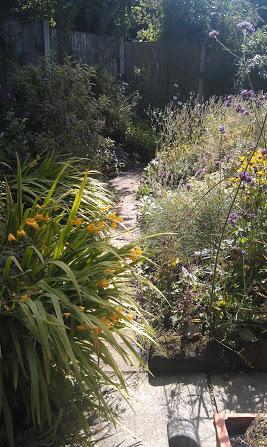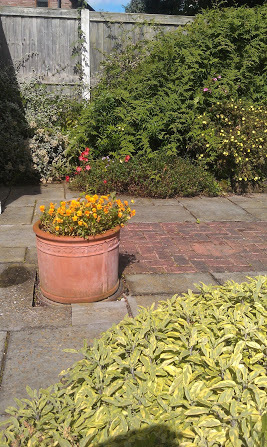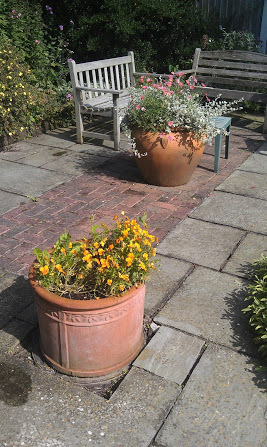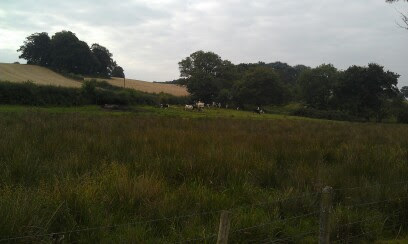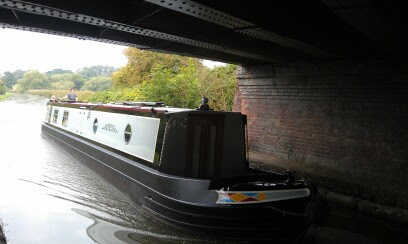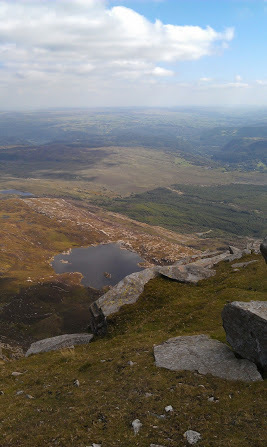David Clayton's Blog, page 27
October 28, 2014
Pictures of a Recently Completed Giant Mural of the Crowning of the Virgin from Malaga, Spain
 The artist Raul Berzosa has sent me the following pictures of his recently completed project. It is of the ceiling of the Oratory of the Brotherhood of Our Lady of Sorrows, Málaga, Spain. It took him a year to paint. The total size of the roof is 12.20 meters long and 9.62 meters wide, with a total of 130 square meters approximately. It is painted in acrylic. His website for more information is here, http://www.raulberzosa.com/. This is a spectacular achievement and it is good to see work of this sort being commissioned and executed. I hope there will be more!
The artist Raul Berzosa has sent me the following pictures of his recently completed project. It is of the ceiling of the Oratory of the Brotherhood of Our Lady of Sorrows, Málaga, Spain. It took him a year to paint. The total size of the roof is 12.20 meters long and 9.62 meters wide, with a total of 130 square meters approximately. It is painted in acrylic. His website for more information is here, http://www.raulberzosa.com/. This is a spectacular achievement and it is good to see work of this sort being commissioned and executed. I hope there will be more!
If I have one point to make, it is my usual one that my personal taste is to see more muted colour and shadow with the brightness concentrated on the principle foci of interest in the baroque fashion. Also, acrylic, the medium which he uses, can have an artificial quality, as though it is permanently lit by fluorescent strip lighting. However, I should state that I have seen only the photographs and so I have not seen the work in situ. For a work like this the impact can be very different when viewed from where it is intended to be seen – this would be viewed ordinarily from a great distance away by observers looking up from the floor. The artist has no doubt designed it with this with this in mind.
October 24, 2014
Hortus Conclusus – The Garden Enclosed
In the Office of Readings, on the Feast of the Visitation, the first reading is from the Song of Songs. It seems to have been a common theme in late medieval art to portray Mary interpreted as the ‘Garden Enclosed’ as referred to in the Song of Songs. As someone who loves gardens I like the idea of the garden having a place in sacred art. (I am talking here of the garden grown for beauty, the ‘flower garden’ as it would be called here in the US).
I am not aware of this being a common subject for artists to paint today and one wonders why? The first answer that comes to mind, almost as a kneejerk response, is that genuine piety for Mary has declined and this is just one more casualty in the devotional lexicon.
It might be this, but also, it is very likely a reflection also of a different attitude to gardens and to man’s place in creation that is prevalent today and especially strong in the US (as I have described before).
Historically, the wilderness was seen the place of untamed nature which is the home of the devil. Christ went to meet him there for 40 days and when monks and hermits went out to the desert, it was not so much as we might think today, to escape the city, but rather to engage in spiritual battle in the wilderness, the lair of the enemy. In the painting below by the Flemish artist Robert Campin (scroll down to the second last), we see the father of monasticism, Anthony Abbot (with St Catherin of Siena, John the Baptist and, I think, St Barbara), now resting in the garden having completed, one presumes, his spiritual battles in the Egyptian wilderness.
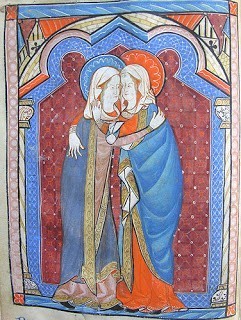 Today, however, the beauty of nature as wilderness is often seen as a higher beauty of nature cultivated. Here in the US where people particularly prize their national parks as places of wilderness unaffected by man. They are wonderful places to visit and very well run. but I am always struck by the fact that they do not preserve the beauty of farmed land. In the UK, where I come from there is no part of the land, as far as I am aware, that is not man-affected, yet I miss the beauty of its countryside very much. Our national parks, such as the Lake District, are preserving a landscape that has been shaped by man for centuries through agriculture and the beauty of which inspired, for example, the poetry of Wordsworth. The wilderness is beautiful, but it is part of a fallen world and we know objectively that by God’s grace man can raise the beauty of nature up to something higher than the wilderness (he is also capable of destroying its beauty too we must remember when attempting to make a judgement on this).
Today, however, the beauty of nature as wilderness is often seen as a higher beauty of nature cultivated. Here in the US where people particularly prize their national parks as places of wilderness unaffected by man. They are wonderful places to visit and very well run. but I am always struck by the fact that they do not preserve the beauty of farmed land. In the UK, where I come from there is no part of the land, as far as I am aware, that is not man-affected, yet I miss the beauty of its countryside very much. Our national parks, such as the Lake District, are preserving a landscape that has been shaped by man for centuries through agriculture and the beauty of which inspired, for example, the poetry of Wordsworth. The wilderness is beautiful, but it is part of a fallen world and we know objectively that by God’s grace man can raise the beauty of nature up to something higher than the wilderness (he is also capable of destroying its beauty too we must remember when attempting to make a judgement on this).
The second point that arises in my consideration of this is the question as to whether or not gardening is a male or a female pastime? Talking to many here in the US, the impression I get is that people see planting vegetables or rearing animals for food as a masculine thing; but growing a garden for its beauty? Definitely not. As a general rule, amongst the students, here, the young men are interested in activities linked to rearing chickens, keeping bees or growing vegetables, but growing flowers? No.
In response to this I would say, as I have mentioned in earlier articles, that Adam was a gardener and Christ, the new Adam, was mistaken for a gardener; and the garden was the place that He went to to pray to his Father. Also, while Mary is identified with the garden, it was the man in the Song of Songs who cultivated the garden and gathered lilies for his love. Furthermore, my great grandfather was head gardener of the Duke of Northumberland (so the family lore goes); my grandfather was and my dad still is a very keen amateur gardener (my father’s garden was even featured once on national television). I don’t expect my citing of family members to persuade many, but it speaks eloquently to me – all were men!
Aristotle it seems to suggest that the natural home for man is the city in close association with others and scripture seems to support this. In psalm 106 the city is the place of culture from which the wilderness is banished and in the Book of Revelation, our final home will be the city of the New Jerusalem; but this is a garden city in which the Tree of Life flourishes and Eden has been restored by Christ the Head Gardener. So perhaps we can conclude from this that the garden is a place of beauty, a retreat for relaxation and contemplation for city dwellers. In the biblical references I have found it is a place in which everything is grown for its beauty and to delight the senses – taste, smell, vision – rather than simply sustenance. The little bit of reading about medieval gardens seems to suggest that, consistent with this, they were designed with both utility and beauty in mind (just as with architecture it seems, utility and beauty are seen as two aspects of what is good). By this the work of man adds harmony to the hymn of the cosmos in proclaiming the glory of God.
Leo XIII said in his encyclical Rerum Novarum, that men (I assume here in the sense of all humanity) should be encouraged to cultivate the land and in so doing will, ‘learn to love the very soil that yields in response to the labor of their hands, not only food to eat, but an abundance of good things for themselves and those that are dear to them [my emphasis].’ In advocating that men grow flowers I am not suggesting that this is part of discover of their ‘feminine side’; rather, that the cultivation of beauty for contemplation should be seen as much a masculine occupation as a feminine one. Perhaps there are parallels here with the feminization of prayer and contemplation that has lead to a drop in the number of vocations. Maybe the antidote lies with fathers – what we need here is fathers who not only lead the family in prayer, but are happy once again cultivate natural beauty as an example to their sons…even if it is only watering a window box to grow the flowers to give to his wife!
Pictures below is Noli me tangere by John of Flanders, 14th century – Christ with holy spade! And below that: Martin Schongauer, Madonna in Rose Garden, 15th century; and below: Gerard David, and Robert Campin, both late gothic Flemish. Picture above are from 14th century English psalters.
October 21, 2014
TMC student commissioned to design a Cosmatesque floor for her parish in Idaho
Here is a heartening story that went out in a recent newsletter from Thomas More College of Liberal Arts descrbes how college senior, Amy Green is designing a Cosmatesque floor for her parish, Good Shepherd Catholic Church in Driggs, Idaho. She is doing this through the weekly Guild of St Luke art class at the college. The article below was written by student Marlene Schuler, Class of 2017. In this Amy describes how this will be done through members of the parish volunteering their time to lay the tiles. She told me in addition that these professional tilers had also managed to negotiate a deal with the tile supplier, who offered them a good price simply because he was taken by how unusual this project is. This is the sort of result that makes it all worthwhile for me. I’m sure Amy will do a great job! Another point is that the article doesn’t say so, but as this is done on a limited budget, they would welcome donations to go towards the finished floor. So here’s your chance to contribute to the rebuilding of Catholic culture. Contact me if you would like to donate and I will put you in touch with Amy and the church.
Anyway here is Marlene’s article, which was headed:
Rebuilding Catholic Culture, One Tile at a Time
What inspired you to start this project?
Initially, it was the Way of Beauty program in freshman year. Then, it was furthered by going to Rome and seeing the Cosmati floors in person; in particular, the floors of San Benedetto and Santa Maria in Trastevere.
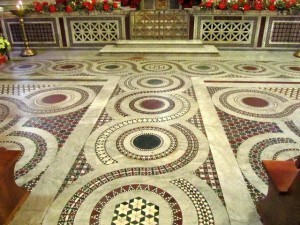
(The Cosmati floor in the basilica Sancta Maria in Trastevere that helped to inspire Amy)
Could you describe a little more how the Way of Beauty Program was able to help you with this design process?
In the second semester of freshman year, Mr. Clayton focuses in on Euclid’s geometry and how it is applied in various art forms. At the end of the semester, we were asked to design a Cosmati floor using the techniques we were taught through the program. I was so struck by how easy this project was and how beautiful the floors turned out; which was incredible for me, because I have never been able to draw.
Currently, I am taking the St. Luke art guild in which Mr. Clayton is able to help me with the design of the floor!
Where are you in the process of design?
I’m in the middle of designing the floor right now. Once I finish the design and our parish has raised the necessary funds for the floor, the project will begin. There are several parishioners who have offered to donate their time, talents, and materials to lay the floor. It’s going to be local parishioners and people from our town (including non-Catholics) all working together on the floor, cutting and laying the tile…. it’ll be like medieval times, when everyone from the village helped out.
I am also designing a website whereby people can donate to the project to help purchase the tile. I am hoping to have the website up and running by the end of this semester.
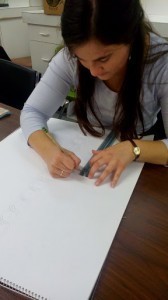
Is this something you would like to continue doing after the project is finished—after your tenure at Thomas More?
If there are other opportunities, I would definitely be open for exploring them. It’s so exciting to be able to use the education that I’ve received here so soon—even before graduating.
October 17, 2014
Announcing a Catholic Arts Conference for Fall 2016 in Omaha, Nebraska – Can Such an Event Be a Success?
There will be a conference for Catholic artists and patrons, covering painting, sculpture, architecture, music and film will take place in Omaha, Nebraska from October 27-29, 2016. Featured speakers are Anthony Visco, Fr Michael Morris (who writes the art articles for Magnificat, Denis McNamara and many other well known names, As well as sharing ideas about art, it will be a showcase for the artists and they will be able to interact with patrons, publishers, liturgical design companies and so on. I anticipate regular updates through the year.This is good news. I am not aware of something done on this scale before and so I pray that it is successful in furthering the new ‘epiphany of beauty’. The website is here.
However it does raise the question in my mind of what the aims of such conference should be and how might they be achieved? I am thinking particularly of the visual arts of painting and sculpture, the area I know best, as I write.
Over the years several people have suggested exhibitions to me as a way of promoting beautiful art and helping Catholic artists. As a rule I am skeptical about their value. The assumption seems to be that there are good artists out there who are unknown, and if we can provide a showcase for their work, it will give them a chance to become known and then patrons will commission them. I think that this assumption is wrong. In this age of the internet it has never been easier for artists to publicize their work. The reality is that there are very few good artists out there, most (not all) of these are trained iconographers and they are already generally known. Furthermore, the vacuum is so great, that anyone who really is any good will be noticed very quickly. So, when the call goes out for submissions and the art comes in, there are usually just a handful of good pieces but not enough for a whole exhibition and the organizers are forced to display much mediocrity just to fill the wall space. The overall, general impression for those who attend is that while the publicity speaks of a return to the values of timeless beauty produced by skillful artisans, they don’t see it in the works on display. In the end art is a good as it looks, and people know what they are seeing. They see the disparity between the rhetoric and the product and will leave discouraged, believing that the future is bleaker than ever.
It might be that I am wrong and the work done in recent years in teaching artists skills and forming them so that they are aware of what constitutes Catholic sacred art has begun to pay off and there are now more good artists out there than I imagine. If so perhaps this event will put some patrons in touch with some artists who were previously unknown to each other. I am skeptical, as I have explained, but would be very happy to be proved wrong so I guess it is always worth a try!
I am a great believer in the idea that when the art is good enough, people will be clamoring to buy it. This is why Popes have stressed the importance of beauty. When it is present it connects with people regardless of how educated and how cultured they are and it sidesteps prejudice. I think that the evidence bears this out; good artists are able to get commissions. This says to me that the work to be done is not so much in publicising the work of artists, but rather in forming them.
Perhaps this conference can do more and play a part in sharing of ideas and in formation in way a simple exhibition does not ? Because of the stature of the people attending, it seems to me that it does offer the possibility of dialogue between creative people and with the Church and it’s patrons. To the degree that it can achieve this, then I think that it can be useful. This dialogue is precisely what John Paul II called for in his Letter to Artists, so that there could be the development of new art that nevertheless participate in the timeless principles of beauty, goodness and truth. The desire is to create new popular forms that speak of and to the Church as it is today without compromising on the essential elements that make the art sacred and Catholic. Pope Benedict spoke of a similar need, for example in Sing A New Song, He talked of the need for artists to move out of the ‘esoteric circle’ (ie their friends at dinner parties!) and connect with ‘the many’.
I believe that this will require all involved to be sincere in seeking to learn from each other try to understand what is needed today. On the whole artists are not good at listening to each other. I just think of my own reactions here. I am keen to meet patrons or people who might pay me for work, but it is easy for me to see other artists as competitors and my instincts are to avoid contact with them. This is my loss. I should be ready to learn from my peers. Raphael, no less, did not hesitate to copy the styles of others if he thought it would help his own, and I think we should be ready to do the same. At such a conference, I would have to try to put aside this tendency and try to be ready humbly to learn from others and especially try to deepen my sense of how prayer and liturgy is connected to the form of art. This might enable my worship to inform my painting and in turn, one hopes, nourish that of others’ too.
In this regard, I am pleased that the organisers have stated their intention to make prayer central to this. I hope that this a conference in which the liturgy – the Mass and the Liturgy of the Hours -punctuates the days and that the organizers think very carefully about the environment in which they take place so that art, music, architecture and worship are all in harmony. By this the attendees might deepen further their instincts for how we engage with art in music in the service of our worship, which in turn will help them to paint better art.
As I have said I think that the signs are good here, so fingers crossed!
The website is www.catholic-artists.com.
October 14, 2014
Paul Jernberg’s Mass of St Philip Neri – CD Available
 One of the best Mass settings in English I have ever heard
One of the best Mass settings in English I have ever heard
A CD of the Mass of St Philip Neri, is Music Director of St Lucy’s and St Monica’s parishes in Methuen, MA. He is also Composer in Residence and Choir Director at Thomas More College of Liberal Arts is now available from www.pauljernberg.com.
The whole Mass is sung, rather like an Eastern liturgy in which priest intones and calls and choir respond on behalf of the congregation. The recording has been done by the Chicago based, Schola Cantorum of St. Peter the Apostle met under the direction of conductor J. Michael Thompson
This has been released to rave reviews (see for example comments from musicians and bloggers including Peter Kwasniewski at the Chante Cafe, here. He says the following ‘Magnificent..one of the best English Mass settings I have ever seen.’
Charles Culbreth, a nationally respected choir director and composer, who has been a regular contributor at Chant Cafe and an important voice over the years in the Church Music Association of America commented: ‘With the consistency of his expertise with Byzantine homophony, combined with near perfection and sheer genius of the harmonic/melodic construct of Paul Jernberg’s setting, it cannot be just coincidence that Palestrina’s patron bears the dedication of this Mass.’
The Our Father
Glory to God in the highest
October 10, 2014
A Suburban English Garden
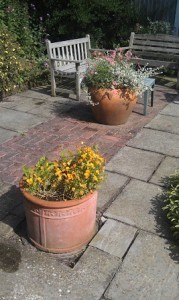 Here are some more photos of my parents’ garden in England taken this summer. I have described before how they have combined the English planting methods – creating herbacious and perennial borders in which no soil is visible – with ideas inspired by Spanish courtyard gardens that they had seen when visiting that country.
Here are some more photos of my parents’ garden in England taken this summer. I have described before how they have combined the English planting methods – creating herbacious and perennial borders in which no soil is visible – with ideas inspired by Spanish courtyard gardens that they had seen when visiting that country.
The back garden is a small patch of ground perhaps 25 yards square. He is divided it up into rectangular areas that are either fully planted beds, or paved with flagstones and brick and dotted with large terracotta plantpots. There is no lawn here.
It is now about four years since it was first planted. The plants are maturing and as a result the amount of work need for upkeep is minimal. The plants just grow and block out the weeds. My parents are now at a stage in life when they cannot do any heavy lifting or hours of work gardening in week. This garden is now at a level where they hire someone to come in once in the spring to romove weeds from between the flagstones and any visible in the beds and generally tidy it up . Then it just grows and looks beautiful. With perhaps the occasional afternoon of deadheading, nothing more is done until the autumn when he will come in and cut down the perennials, prune the shrubs and again remove any visible weeds. I was commandeered for a couple of deadheading sessions in my visit!
Those who might have seen past articles about this garden will see how it is matured and changed in just a short time.
Anyway, here are some photographs (some, as you will see, taken before the dead heading was complete!).
October 3, 2014
A Walk in England Along the Shropshire Union Canal
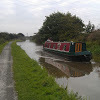 After pictures of Wales, here is different sort of experience of man’s work with the land. It is a walk (definitely a walk and not a hike) along the towpath of an 18th century canal near Chester in Cheshire, England. This is just about 5 miles from where I grew up. The Cheshire countryside is prime agricultural land. Never dramatic enough to be a tourist destination, I nevertheless love the gentle charm of the lush pastureland particularly when it is used for it designated purpose and you see dairy cattle or horses grazing.
After pictures of Wales, here is different sort of experience of man’s work with the land. It is a walk (definitely a walk and not a hike) along the towpath of an 18th century canal near Chester in Cheshire, England. This is just about 5 miles from where I grew up. The Cheshire countryside is prime agricultural land. Never dramatic enough to be a tourist destination, I nevertheless love the gentle charm of the lush pastureland particularly when it is used for it designated purpose and you see dairy cattle or horses grazing.
The canals of Britain are an interesting man made feature that now look a natural part of the landscape. Made for transportation of heavy loads of materials they fueled the early industrial revolution and then fell into decline when the railways were established. So over just a short period, perhaps 50 years or so, at the end of the 18th and beginning of the 19th century a network was built across the country, each one an investment project for entrepreneurs, as the the railways were to become later. They fell into disrepair and lay stagnant for many years. Then in latter years, perhaps the last 50 were seen in a different light and have been dredged and cleaned. The old long boats which used to haul coal or iron ore have now been converted into floating mobile homes for holidays. The towpaths which were made for horses to walk along as they pulled the long boats canals are no longer trade routes, were turned into footpaths fobut they are navigable old canal boats are still in use for recreation.
They are a product of liberal capitalism and industrialization built with none of the sort of regulation and public money that such things would very likely require today, the forces that are identified very often with all that is ‘satanic’ to quote William Blake, about the modern world. Yet they are now, along with the factories, mill owners mansions and workers built during the period seen as objects of beauty. The canals are even regarded as positive aspects of the countryside as natural as a stream or river because of the habitats for wildlife they provide. As a Christian who believes that the work of man is natural and good (when guided by God’s grace) and not automatically destructive this is no surprise to me; although it may cause a few hardline greens to hesitate for a moment and think about their worldview.
The canals were built to connect the industrial cities and their start and end points are often modern industrial towns (which can be ugly). Birmingham has, so I was told at school, more mileage of canal than Venice. The Shropshire Union Canal actually starts in a place called Ellesmere Port and is a branch of the Manchester Ship Canal. This old industrial Britain close to Liverpool on the River Mersey. I think that even the locals would hesitate to recommend it as a tourist spot It would be a bit like starting off in Flint, Michigan. While the exact point of departure, shown below has some 18th century buildings that are not unattractive, the first section does take you through some of Ellesmere Ports main features, the oil refinery and car factory…no the most photogenic.
But as you start to get into open country the scenery improves.
An old canal boat. What might have carried huge loads of coal in the past is now a holiday boat.
And another!

The lines of these old brick bridges are very attractive I think. Perhaps those who design the bridges that go over our motorways could learn from this?
I climbed up onto this one to have a look at the farm track that crosses over the canal.
The immediate scene is pretty, but the pylons in the distance indicate that we are still just coming out of a built up industrial area. The canal with the bridges and boats is as much an industrial landscape as the Stanlow oil refinery we see in the distance. We will know that Western culture has undergone the epiphany of beauty when even an oil refinery is a place of uplifting beauty… but we’re not there yet!
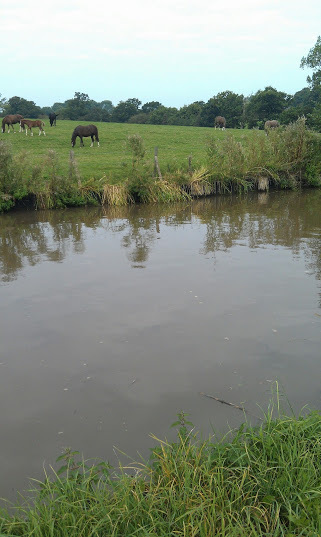
September 29, 2014
Why the JPII’s Theology of the Body says that Nude Figure Drawing is a Bad Thing
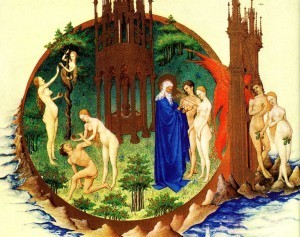 When Pope John Paul II presented his Theology of the Body and addressed artists directly, challenging them to portray the human figure ‘naked without shame’ and in such a way that the beauty of the human form would be revealed in an ordered way it caused quite a stir.
When Pope John Paul II presented his Theology of the Body and addressed artists directly, challenging them to portray the human figure ‘naked without shame’ and in such a way that the beauty of the human form would be revealed in an ordered way it caused quite a stir.
Here was a Pope, now saint, it seemed, who was putting his intellectual weight behind the artistic tradition of painting the nude and not only excusing it, but promoting it. Finally Catholics who fancied themselves as arty and cultured could hold their heads up high at dinner parties amongst their sophisticated, non-Christian friends and happily say that although there were some puritanical elements in the Church, those who were uncomfortable with nudity were just narrow minded philistines who didn’t really understand Catholic culture. It inaugurated the creation of a wave of contorted Theology-of-the-Body nudes that, the artists told us, communicated human sexuality ‘as gift’ by gesture.
I didn’t get around to doing the paintings, but I did believe for a long time that JPII was a Catholic apologist for the Sixties, who could see the good at its heart and was able to distinguish, deftly, between those elements that were disordered or and those that reflected an ordered view of the human person. I also believed that the study of the nude was essential in the training of the human body.
Then I read the Theology of the Body and attended an atelier in Florence in which I did figure painting or drawing every afternoon. Now I am not so sure.
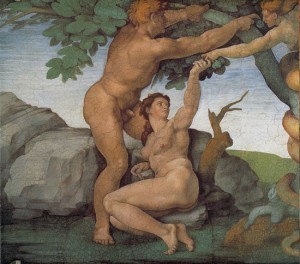 First, I no longer believe that the study of the nude is necessary in an artist’s training. The method I studied relied on training the eye, not anatomy. In fact we were told not to think deeply about the structure of what we were observing. Moreover, there have been great naturalistic artists who were masters of the academic method and did not train with the nude, such as Velazquez and his contemporaries in the Spanish school of baroque naturalism. I understand that even today, the Russian school of academic art in Florence, Italy does teaches today to the highest level without painting the nude.
First, I no longer believe that the study of the nude is necessary in an artist’s training. The method I studied relied on training the eye, not anatomy. In fact we were told not to think deeply about the structure of what we were observing. Moreover, there have been great naturalistic artists who were masters of the academic method and did not train with the nude, such as Velazquez and his contemporaries in the Spanish school of baroque naturalism. I understand that even today, the Russian school of academic art in Florence, Italy does teaches today to the highest level without painting the nude.
Also, my understanding of JPII’s writing has changed. What I see now in his writings about art and nudity, which include the ToB, is someone who understands the differing traditions in art very deeply and who is conservative by nature. In fact he was strongly against the portrayal of the nude in naturalistic styles that must, by virtue of their naturalism, portray Historical Man that is, man after the fall (those painting or sculpting in the style of the 19th century atelier take note).
Furthermore, he said that only when the body is shining with the ‘light that comes from God’ can it have dignity when naked. This is a reference to what in the context of the icon is called the ‘uncreated light’. He is proposing therefore that only highly idealised representations of the human form are appropriate such as we might see in the iconographic form. In common with other Christian commentators he also sees great dignity in the nudes of ancient Greece. It is the correspondence to this idealised form, and not its naturalism, I suggest that causes him to appreciate the work of Michelangelo so highly, especially his frescoes in the Sistine Chapel. He sees each as a way of portraying the glory that was present in man before the Fall. After the Fall, dignity of Historical Man was restored by putting clothes on, not by taking them off.
We must also consider not only the effect of the image on the observer, but also how the process of creating the image affects both the model and artist. It is often stated that the etiquette of the studio, in which the model disrobes behind a screen and no one other than the studio master speaks to him or her when nude, protects the dignity of the model. In fact, if it does to some degree remove the general indignity of baring all in front of others and the erotic charge that is present when the model is attractive (and I am skeptical about that) then it does so by objectifying the person. That is, it creates a situation in which we no longer view the model as a person, but impersonally as a flesh shape, a nude. This is therefore participating, albeit in a different way, in the problem of today’s understanding of the human person that the Pope is trying to remedy – it removes the dignity of the person so that they are just forms of flesh to be used.
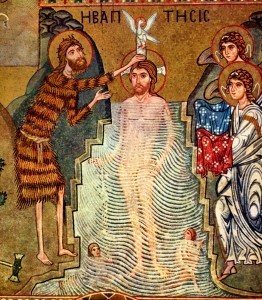 Only the person bathed in the uncreated light of God and those artistic styles developed to portray him are appropriate for nudity, says John Paul II, for, ‘If it is removed from this dimension, it becomes in some way an object which depreciates very easily, since only before the eyes of God can the human body remain naked and unclothed, and keep its splendor and its beauty intact.’
Only the person bathed in the uncreated light of God and those artistic styles developed to portray him are appropriate for nudity, says John Paul II, for, ‘If it is removed from this dimension, it becomes in some way an object which depreciates very easily, since only before the eyes of God can the human body remain naked and unclothed, and keep its splendor and its beauty intact.’
I have not formed a definitive view on this matter. But at the moment my own position is that even if it was possible in the past, in this present age when the dignity of the human person is under attack, we must be more conservative rather than less, and put some clothes on our models.
I am open to arguments that reinforce the place of the naturalistically portrayed nude in the canon of Christian art and in the training of the artist.
This is a very short summary of a much longer article (10,000 words) that appears in The Beauty of God’s House: Essays in Honor of Stratford Caldecott published by Cascade Books. I would love to hear readers’ comments on this, but I ask that if you have strong views on the matter you read the full reasoning in the article above before doing so. Just in case you are wondering, I get no royalties for this. I am asking this in order that you might understand fully why I have reached these conclusions before writing.
Above and below, legitimate nudes: all the paintings above show the figure in highly stylized form and therefore come under the criteria approved by JPII, or else as a baby. The nudity of babies does not offend ever I suggest (I explore the reasons why in my article).
September 26, 2014
A Walk in Wales
Here are some photographs of a walk my brother, Rob, and I took on trip this past month to Britain. We climbed a mountain in North Wales. It was about a 3000ft climb from a town called Capel Curig. The mountain peak is Moel Siabod (pronounced Mole Shabod). The wild terrain is typical high sheep paster. The purple tinge to the hills is the flowering heather which was not quite in full season.
It was a beautiful day and when there’s no wind and the sun shines it all seems very benign. But come wind, rain and snow and its a different story. In fact we tried to climb the same route about three years ago and had to turn back because the mist was so thick that became too dangerous to continue and we turned back. As you can see from the photos, the peak of the mountain is on a ridge, one side of which is a sheer drop of several hundred feet.
This is the beauty of a landscape farmed by man for centuries. No wilderness here!
The path start alongside a stream and then you start to climb up through the trees and emerge on to the fells.
Below, halfway up and time for a snackette!
We stop occasionally to look at the path we have just climbed.
The heather is just coming into bloom…
As we approach the top we hit the ridge and can see the steep sided drop on the other side with the lake below
And from the top, the views are magnificent
The sheep seem to be enjoying the views too!
September 23, 2014
The Beauty of God’s House – a Collection of Essays Published as a Tribute to Stratford Caldecott
 Readers might be interested to know of newly published book, the Beauty of God’s House, which is a Festschrift for Stratford Caldecott. It is a collection of essays edited by Prof Francesca Murphy and features contributions from the Davids Schindler, Marc Ouellet, John Milbank, Aidan Nichols, Adrian Walker, Jean Borella, David Fagerburg, Nick Healy Jr, Michael Cameron, Phil Zaleski, Carol Zaleski, Derek Cross, Mary Taylor, Reza Shah-Kazemi, and myself with an afterword by his wife Leonie Caldecott.
Readers might be interested to know of newly published book, the Beauty of God’s House, which is a Festschrift for Stratford Caldecott. It is a collection of essays edited by Prof Francesca Murphy and features contributions from the Davids Schindler, Marc Ouellet, John Milbank, Aidan Nichols, Adrian Walker, Jean Borella, David Fagerburg, Nick Healy Jr, Michael Cameron, Phil Zaleski, Carol Zaleski, Derek Cross, Mary Taylor, Reza Shah-Kazemi, and myself with an afterword by his wife Leonie Caldecott.
The book covers the whole range of Caldecott’s interests, from poetics to politics. Anyone interested in the field of theology and the arts will find much to intrigue them. If there is a common thread that runs through them all it is, as the title suggests, Stratford’s interests is in the beauty of the cosmos and how it reflects the beauty of God.
I contributed an essay on the place of the nude in Christian art in the light of JP II’s Theology of the Body (and other writings including his address at the opening of the newly restored frescoes of the Sistine Chapel and his Letter to Artists). The common lore has him as a Catholic apologist for the Sixties who stripped the loin cloths and fig leaves from the Sistine Chapel. In fact he spoke very strongly against naturalistic representations of the nude and I argue that in fact he was as about as conservative in his approach to the pictorial representation of nudity as Pius IV (who had some fig leaves painted on the Sistine Chapel some years after it was first painted).
I don’t explain in the essay, but the reason I wrote this arises directly from conversation with Strat and Leonie Caldecott some years ago. I was working with both at the time to organise a summer drawing school in Oxford teaching the academic method and we were looking for a model for a life drawing class that was to be included. We couldn’t find one and in the end someone we all knew well volunteered, but she would not disrobe. None of us wanted her too either because we knew her and that alone made it seem inappropriate. So what we did in the end was ask her to model, elegantly dressed, for what we called a full-figure portraiture class. Realising that if I was going to establish an art school for Catholics I was going to have to address this issue head-on I decide to do some research.
At that time I had unquestioningly accepted the received wisdom that came from Catholics and non-Catholics alike that it was part of the tradition and necessary for any good training of an artist. Therefore, I was looking to find justifications for the nude and for figure drawing as a practice that I could use against what I perceived to be over puritanical Catholics. I immediately headed for JPII believing he would be my great ally here, as well as various other authors. Strat suggested to me that I read an article that had been printed in Communio some years earlier. It was a reprint of a piece written by a contemporary and friend of Jacques Maritain called Erik Petersen and was entitled A Theology of Dress. Here was the complementary theology to the Theology of the Body and I found that the two were founded on complete harmony of thought. As I studied these writings and the Catholic tradition of figure painting, to my surprise I came to the opposite conclusion. I felt that the place of the nude in the Catholic tradition had been greatly exaggerated latterly and also that nude figure drawing is not necessary for the training of artists. The article explains my thinking in detail.
I intend to post a review of the book when I have read the contributions of the other authors.
It is available from the publisher, Cascade Books, here.
David Clayton's Blog
- David Clayton's profile
- 4 followers












